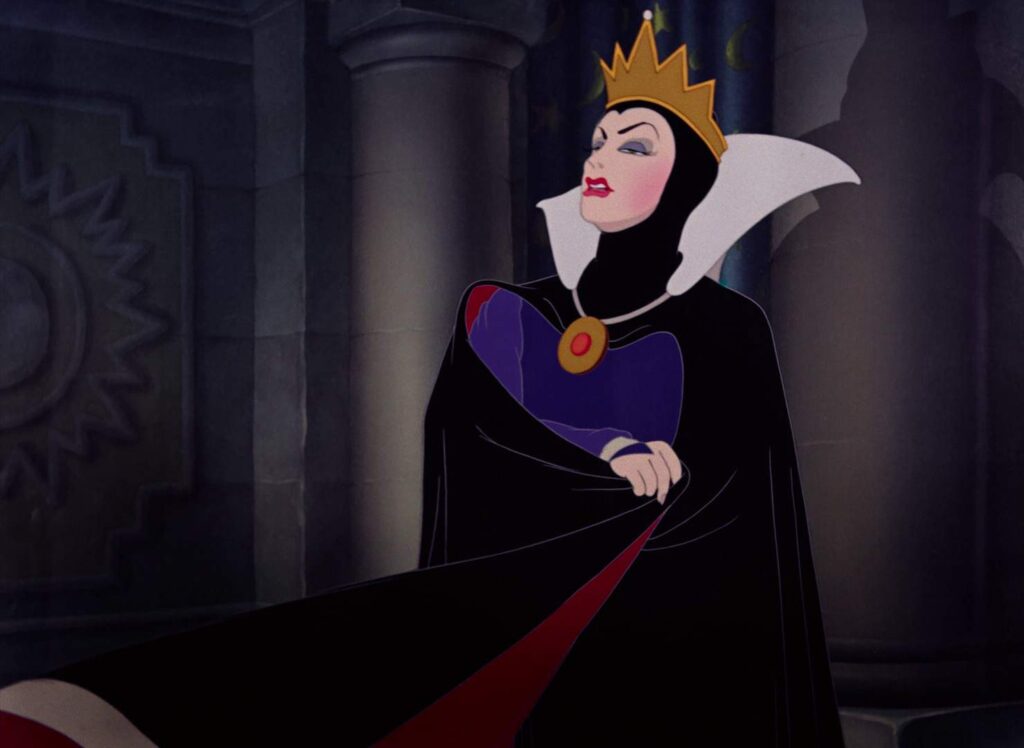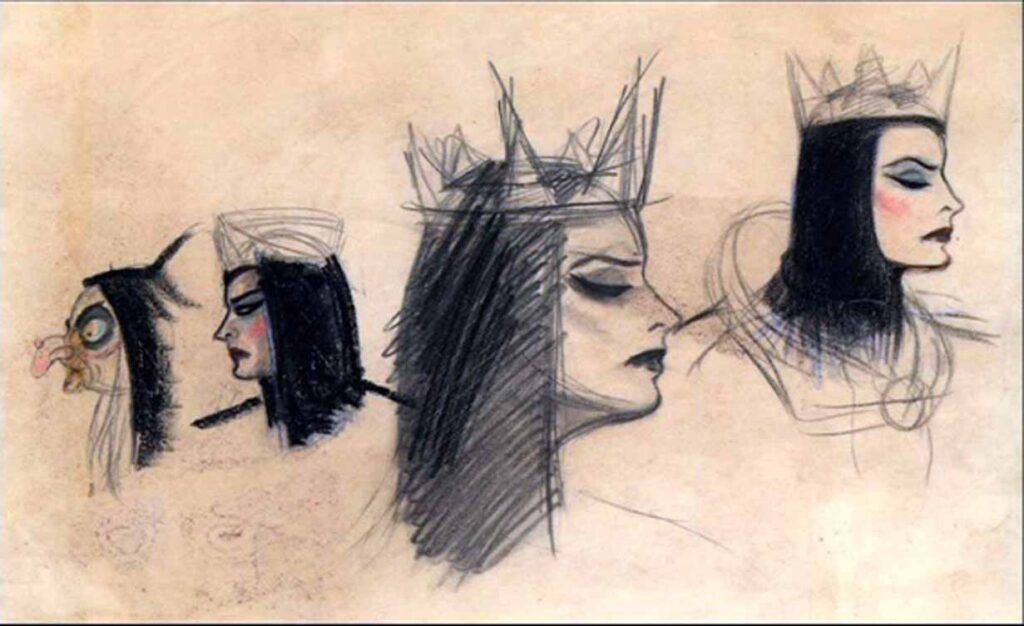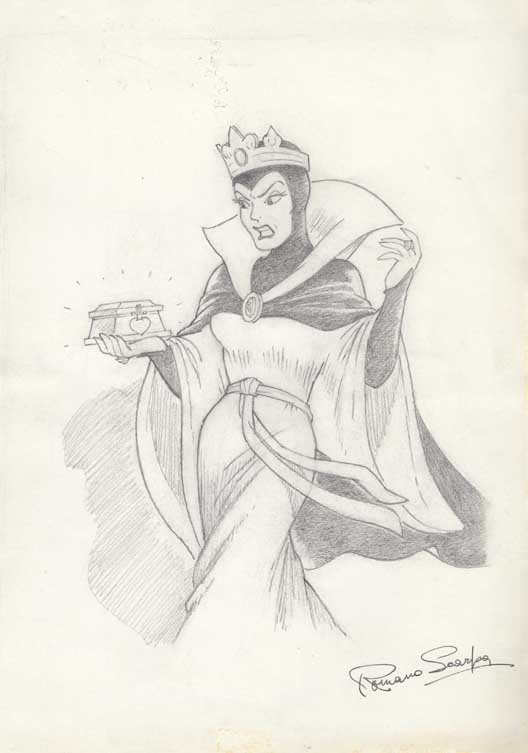Information
Full name: unknown, but is called Grimhilde in production documents and in the original comic strip adaptation
Age: unknown
Designers: Joe Grant, Albert Hurter, Ferdinand Horvath, Gustaf Tenggren
Animators: Arthur Babbitt, Robert Stokes, Eric Larson, Campbell Grant, Sam Dawson & Tony Rivera (Young Queen) ; Norman Ferguson, Tony Rivera, Frank Kelling, John Lounsbery, Bill Roberts, Nick George & Chester Cobb (Witch)
Voice actor: Lucille La Verne
Models: Sylvia Lamarr (unconfirmed) (Young Queen) ; Lucille La Verne, Don Brodie, Nestor Paiva, Paul Godkin
Appears in sequences: 1B, 2A, 2B, 3A, 7A, 9A, 10B, 13A, 14C, 14F, 14H, 14J
Back to Cast

Two sides of Evil
The Queen is a highly paradoxical character. Walt Disney has taken a typical fairy-tale character, obsessed with remaining the most beautiful in her kingdom, and turned her into the ultimate Hollywood villain.
As a matter of fact, although she is called Grimhilde in production meetings, which transpired in the comic strip adaptation, she remains nameless in the film, and is referred to in various media as “the wicked Queen” originally, which was changed in the 21st century to “the evil queen”.
But the character’s paradox also lies in her duality. Without the continuity of the story, it would be hard to believe that the woman at the beginning of the film is the same as the one in the second part, because in order to keep her beauty, the Queen herself knowingly loses it, transforming herself into an ugly old witch. This situation leads to the surreal scene in which, having just poisoned Snow White, the ugly old hag yells, “Now, I’ll be fairest in the land!”
But beyond appearance, everything changes in the character: her gait, her distinction, which required different animators; her diction… Whereas the sovereign sometimes addresses her various interlocutors in verse, the witch more readily adopts everyday phrasing, with accents that sometimes border on the folksy.
Yet it is a single actress who provides her voice, albeit with a very different acting style. The transformation would require several actresses in many foreign dubbings.
The Queen was to appear in several scenes that were cut at various stages of production. These included imprisoning the Prince in a dungeon, mixing her poisoned drink with a human femur in a cauldron, and other adventures.
Design
In the tentative Outline of 10/22/1934, the Queen is described as “A Mixture of Lady Macbeth and the Big Bad Wolf – Her Beauty is Sinister, Mature, Plenty of Curves – She Becomes Ugly and Menacing When Scheming and Mixing Her Poisons – Magic Fluids Transform Her Into An Old Witchlike Hag – Her Dialogue And Action Are Over-melodramatic, Verging on the Ridiculous.”
As we know, over time, the team would move further and further away from this initial concept, drawn from the previous canons of animation where a completely serious and frightening character didn’t exist, at a time when a cartoon was a pretext for lining up gags.
Joe Grant is responsible for the final versions of the Queen. A model, probably Sylvia LaMarr, shot the character’s initial scenes, which inspired animators Arthur Babbitt and Robert Stokes in particular. For the Witch, other models were hired, starting with Lucille La Verne, who was unsuccessful, and was mainly replaced by Don Brodie. Nestor Paiva and Paul Godkin also seem to have turned out for this purpose. Animators Norman Ferguson and Frank Kelling share most of the scenes.


The Queen’s legacy
As early as 1935, the nameless queen of the film was christened Grimhilde during production, a name that rhymed with “killed”, and although it is never uttered in the film, the name found its way in the comic book adaptation. It was a medium in which the character flourished: the Queen returned in many of the stories in which Snow White was sometimes absent, drawn by Tony Strobl and, above all, Romano Scarpa.
Apart from a few appearances in Who Framed Roger Rabbit? and other anecdotal productions, the Queen made a strong comeback in the series House of Mouse and in a humorous version in the series The Wonderful World of Mickey Mouse.
She is played by Gal Gadot in the 2025 remake.
Countless derivative products in her effigy have been produced, including statuettes, dolls, cut-outs and, of course, an infinite number of books, some of which espouse her point of view of the story, such as Serena Valentino’s Fairest of All.
Other Productions
Appears in the following productions:
Snow White and the Seven Dwarfs (Live on stage) (1969)
Who Framed Roger Rabbit? (1988)
House of Mouse (2001)
Mickey’s House of Villains (2002)
Snow White — An Enchanting Musical (2004)
Once Upon an Apple (2021)
Once Upon a Studio (2023)
Snow White (2025)
Go to Sequels and references
